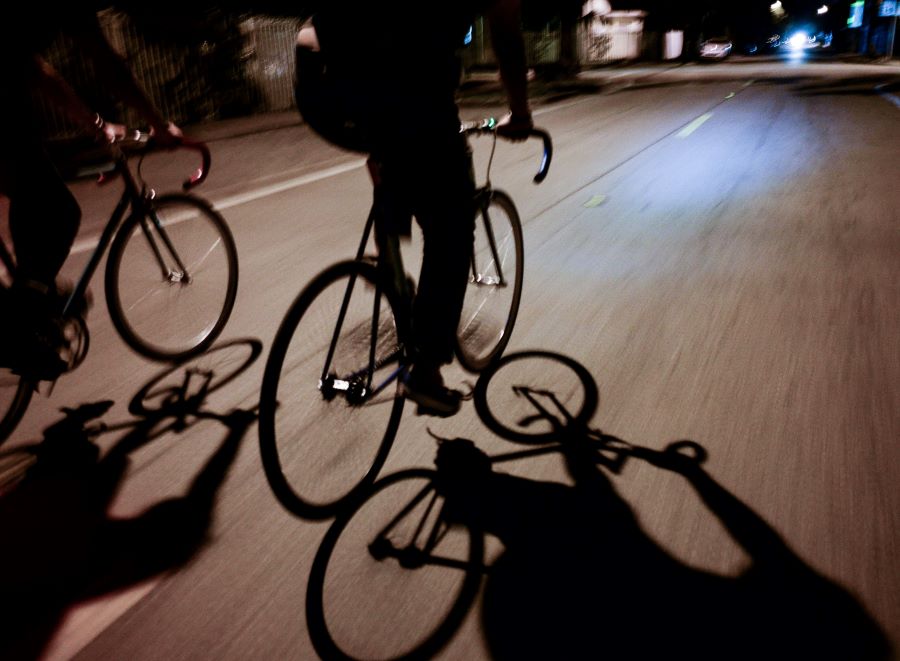Data collected by the National Highway Traffic Safety Administration (NHTSA) shows that more cyclists are being killed at night compared to during the day. In fact, around 859 cyclists were killed while cycling at night in 2017 – a 6.3% increase when compared to the year before. The most obvious danger while driving at night is visibility, but there’s also a higher number of people driving under the influence on the roads.
What the California Vehicle Code States
The California Vehicle Code 21201(d) outlines the legal safety requirements of all cyclists. To sum up, it says that the following measures must be taken when cycling at night on a highway, sidewalk, or other legal bikeway:
- A white light is mounted to the front of the bike while the bike is in operation, which must be visible from the front and side by a distance of 300 feet.
- A red reflector or solid/flashing red light with a reflector built-in must be affixed to the rear of the bike. When directly in front of motor vehicles, this light must be visible up to 500 feet.
- On each pedal, ankle, or shoe, a yellow or white reflector must be present and visible for up to 200 meters.
- A yellow or white reflector is affixed to each side of the bicycle forward of the center – and a red or white reflector is attached to the sides of the rear section of the bike. The only exception is when a bicycle has reflective tires.
If every cyclist followed the law to the letter, there would be far fewer nighttime cycling accidents because drivers would be able to see them more clearly. However, many cyclists choose not to follow the law, which is often difficult to police anyway.
Additional Safety Measures to Take When Cycling at Night
Aside from following the safety guidelines outlined in the California Vehicle Code, cyclists can take additional safety measures to reduce the chance of being involved in an accident. For example, to make sure the head is protected, a high-quality helmet should be worn; many of them come with lights attached to them.
The position of a bicycle always plays an important part when it comes to visibility. At night, motorists are often looking straight ahead, so it’s a good idea for cyclists to move further into the road as they would usually. Doing this means they’re automatically in a driver’s field of view, which reduces auto accidents.
Even though powerful lights and reflectors are essential for cycling at night, powerful beams can obscure the vision of oncoming drivers. If a light has a flashing mode or option to reduce lumens, these should be activated when driving towards other vehicles.
Being left in complete darkness while cycling is extremely dangerous, which is what would happen if a battery was depleted, or a light stopped working. To avoid being left in the most hazardous circumstance, carry a spare battery and spare lights.
Much Smaller and Less Visible
Bicycles are the smallest mode of transport using the roads, which makes them much more difficult for car and truck drivers to see, especially when it’s dark outside. When motorists can’t see a cyclist, they’re much more likely to be involved in a collision, which more often than not results in serious injuries or fatalities.
Difficulty Seeing Hazards
Just as motorists have a difficult time seeing bicycles at night, cyclists will also have trouble seeing upcoming hazards including uneven surfaces and potholes. The best way to steer clear of these hazards at night is by using roads that you’re familiar with and are well-suited to cycling.
More Chance of Being Mugged or Attacked
Falling off a bike or being struck by a vehicle are only two of the dangers of cycling at night. Just as there are more motorists driving under the influence at night, you’re more likely to come across various criminals who may mug or attack you. As a precaution, make sure you stick to well-lit and well-populated areas at night; nobody would hear you if you were attacked in a remote area.
Even though you’re on a bike and may have a speed advantage over would-be criminals, it’s best to avoid routes you wouldn’t feel comfortable walking alone on at night.
Cycling is a fantastic way to get around, but it’s essential to take every safety precaution possible when out and about at night. The most common dangers to be aware of are being struck by vehicles, falling down because of potholes or other hazards, and being attacked.
If you or a loved one has been injured while cycling at night, and it wasn’t their fault, visit Payam LA at the following locations:
- Beverly Hills – 8383 Wilshire Blvd, Suite 830, Beverly Hills, CA 90211
- Los Angeles – 212 East Pico Blvd, Suite #4, Los Angeles, CA 90015
- Tulare – 100 E. Cross, Suite #122, Tulare, CA 93274
- Hanford – 13400 Hanford Armona Rd, Suite #B
Or call now for a free consultation on (877) 729-2652 or (323) 782-9927.














